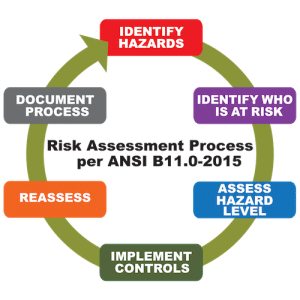
How to do a risk assessment
“What is a risk assessment?” This post aims to allow you to answer basic questions on risk assessments such as “a definition of risk assessment”, “why do risk assessments?”, “when to do a risk assessment?” and “how to do a risk assessment?”.
What is a risk assessment?
The HSE’s definition of a risk assessment is: “….a careful examination of what, in your work, could cause harm to people, so that you can weigh up whether you have taken enough precautions or should do more to prevent harm….” A risk assessment is a vital element for health and safety management and its main objective is to determine the measures required to comply with statutory duty under the Health and Safety at Work Act 1974 and associated regulations by reducing the level of incidents/accidents.
Why do a risk assessment?
A risk assessment will protect your workers and your business, as well as complying with law. As for when to do a risk assessment it should simply be conducted before you or any other employees conduct some work which presents a risk of injury or ill-health. A person from your organization needs to attend risk assessment training as it will ensure that this person is competent within your organization and will gain abilities such as hazard identification, ability to categorise and evaluate risk(s).
How to do a risk assessment
There are no fixed rules on how a risk assessment should be carried out, but there are a few general principles that should be followed. Five steps to risk assessment can be followed to ensure that your risk assessment is carried out correctly, these five steps are:
Step 1: Identify the hazards
In order to identify hazards you need to understand the difference between a ‘hazard’ and ‘risk’. A hazard is ‘something with the potential to cause harm’ and a risk is ‘the likelihood of that potential harm being realised’. Hazards can be identified by using a number of different techniques such as walking round the workplace, or asking your employees.
Step 2: Decide who might be harmed and how
Once you have identified a number of hazards you need to understand who might be harmed and how, such as ‘people working in the warehouse’, or members of the public.
Step 3: Evaluate the risks and decide on control measures
After ‘identifying the hazards’ and ‘deciding who might be harmed and how’ you are then required to protect the people from harm. The hazards can either be removed completely or the risks controlled so that the injury is unlikely.
Step 4: Record your findings
Your findings should be written down it’s a legal requirement where there are 5 or more employees; and by recording the findings it shows that you have identified the hazards, decided who could be harmed and how, and also shows how you plan to eliminate the risks and hazards.
Step 5: Review
your assessment and update as and when necessary You should never forget that few workplaces stay the same and as a result this risk assessment should be reviewed and updated when required.
do a risk assessment?”.

